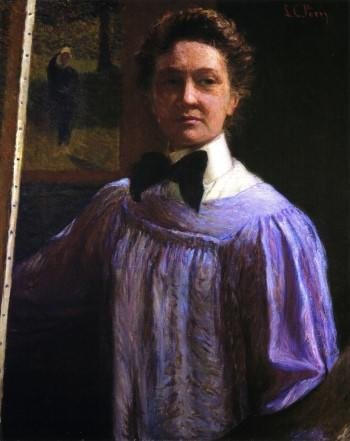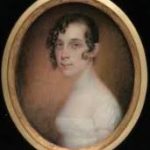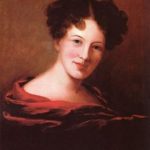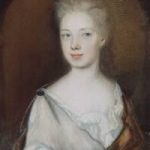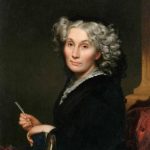First Woman Impressionist Artist in the United States
Mary Cassatt (1844-1926) was an American painter and printmaker. She was the first American Impressionist artist and one of the greatest artists our country has ever produced. She lived much of her adult life in France, where she first befriended Edgar Degas and later exhibited among the Impressionists. Cassatt (pronounced ca-SAHT) often created images of the social and private lives of women, with particular emphasis on the intimate bonds between mothers and their children.
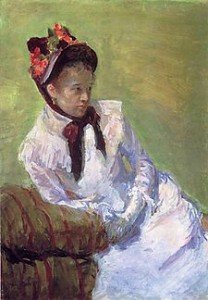 Early Years
Early Years
Mary Stevenson Cassatt was born on May 22, 1844 in Allegheny City (now part of Pittsburgh), Pennsylvania. Her father Robert Simpson Cassatt was a successful stockbroker and land speculator and her mother Katherine Kelso Johnston came from a banking family. Cassatt was one of seven children, of which two died in infancy. Her family moved eastward, first to Lancaster, Pennsylvania, then to the Philadelphia area, where she entered school at age six.
Image: Portrait of the Artist
Mary Cassatt, circa 1878
In the 1850s Cassatt and her family spent five years in Europe and visited many of the capitals, including London, Paris and Berlin. She had her first lessons in drawing and music while abroad and learned German and French. Her first exposure to French artists Ingres, Delacroix, Corot and Courbet was likely at the Paris World’s Fair of 1855. When Cassatt’s oldest brother Robbie died, the family returned to Philadelphia.
Though her family objected to her becoming a professional artist, Cassatt began studying painting at the Pennsylvania Academy of the Fine Arts in Philadelphia – among the few such schools open to female students – at age fifteen. Serious painting was a profession dominated by men in the 19th century. When told by his daughter that she wanted become a professional artist, Mr. Cassatt is reputed to have replied, “I’d rather see you dead first.”
Part of her family’s concern may have been Cassatt’s exposure to feminist ideas and the bohemian behavior of some of the male students. About 20% of the students were female. Though most were not bent on making a career of art, they viewed art as a valid means of achievement and recognition, and a socially valuable talent. Cassatt, however, was determined to become a professional artist, and continued her studies during the Civil War years.
Impatient with the slow pace of instruction, the patronizing attitude of the male students and teachers, and the restrictions placed on women students in the Academy. Female students could not use live models and the principal training was primarily drawing from casts. She later said, “There was no teaching” at the Academy, and decided to study the old masters on her own.
She finally persuaded her parents to let her study abroad, and she was well-equipped to travel in Europe, having learned French and German while living there with her family in the 1850s. In 1866, she began her European travels with her mother and family friends as chaperones.
When Cassatt arrived in Europe for a four-year stay at age twenty-two, she settled in Paris. Since women were not allowed to attend the Ecole des Beaux-Arts there, she applied to study privately with masters from the school. Clearly skilled, she was accepted as a student by Jean-Leon Gerome, a highly regarded teacher known for his hyper-realistic technique and his depiction of exotic subjects.
Cassatt augmented her artistic training with copying the paintings at the Louvre (she obtained the required permit which was necessary to control the copyists, usually low-paid women who daily filled the museum to paint copies for sale). The museum also served as a social meeting place for Frenchmen and American female students, who were not allowed to attend cafes where the avant-garde socialized.
In 1868, Cassatt also studied with artist Thomas Couture, whose subjects were mostly romantic and urban. On trips to the countryside, the students drew from life, particularly the peasants going about their daily activities. One of her paintings, A Mandoline Player (1868) – in the Romantic style of Corot and Couture – was accepted by the selection jury for the Paris Salon, considered at the time the most important venue for artists.
The French art scene was in a process of change, as radical artists such as Courbet and Manet tried to break away from accepted Academic tradition and the Impressionists were in their formative years. Cassatt continued to work in the traditional manner, submitting works to the Salon for over ten years, with increasing frustration.
Cassatt returned to the United States in the late summer of 1870 and lived with her family in Altoona. Her father continued to resist her chosen vocation, and paid for her basic needs, but not her art supplies and her painting suffered. She placed two of her paintings in a New York gallery and found many admirers but no purchasers. She tried her luck in Chicago but lost some of her early paintings in a gallery in the Great Chicago Fire of 1871.
Cassatt even considered giving up art, as she was determined to make an independent living. She wrote in a letter of July, 1871:
I have given up my studio and torn up my father’s portrait, and have not touched a brush for six weeks nor ever will again until I see some prospect of getting back to Europe. I am very anxious to go out west next fall and get some employment, but I have not yet decided where.
Shortly afterward, her work attracted the attention of the Archbishop of Pittsburgh, who commissioned her to paint two copies of paintings by Correggio in Parma, Italy, advancing her enough money to cover her travel expenses and part of her stay. In her excitement she wrote, “O how wild I am to get to work, my fingers farely itch and my eyes water to see a fine picture again.”
With Emily Sartain, a fellow artist from a well-regarded artistic family from Philadelphia, Cassatt set out for Europe again. Cassatt attracted much favorable attention in Parma and was supported and encouraged by the art community there: “All Parma is talking of Miss Cassatt and her picture, and everyone is anxious to know her.”
Career in Art
After completing the commission for the archbishop in Parma, Cassatt studied in Paris, Rome, Parma and Seville, often traveling alone. Her painting Two Women Throwing Flowers During Carnival was well received at the Paris Salon of 1872. These Salons were annual exhibitions sponsored by the French, but were open to all artists.
Cassatt moved her residence to Paris in 1874, where she shared an apartment with her sister Lydia; their parents joined them three years later. Cassatt eventually bought a property northwest of Paris, the Chateau de Beaufresne, purchased with money she had earned as an artist, recognizing that she had found a more accepting work environment abroad.
She expressed criticism of the politics of the Salon and the conventional taste that prevailed there. She saw that works by female artists were often dismissed with contempt unless the artist had a friend or protector on the jury, and Cassatt would not flirt with jurors to curry favor. Her cynicism grew when one of the two pictures she submitted in 1875 was refused by the jury, only to be accepted the following year after she darkened the background.
She quarreled with Emily Sartain, who thought Cassatt too outspoken and self-centered, and eventually they parted. Out of her distress and self-criticism, Cassatt decided that she needed to move away from genre paintings and onto more fashionable subjects in order to attract portrait commissions from American socialites abroad. In 1877, however, both her paintings were rejected, and for the first time in several years she had no works in the Salon.
Impressionism
In 1875 Cassatt had seen pastels (paintings created with sticks of color composed from pure pigment and a binding medium) by Edgar Degas, who worked with the Impressionists, in an art dealer’s window. “I used to go and flatten my nose against that window and absorb all I could of his art,” she later recalled. “It changed my life. I saw art then as I wanted to see it. I began to live.”
That same year, Degas saw Cassatt’s entry in the French Academy Salon. He was quite taken with the work and invited her to join the Impressionists, a group that had begun their own series of independent exhibitions in 1874 with much success. They already had one female member, artist Berthe Morisot, who became Cassatt’s friend and colleague.
The Impressionists had no formal standards and their work varied considerably in subject matter and technique. They tended to prefer open air painting and the application of vibrant color in separate strokes with little pre-mixing, which allows the eye to merge the results in an “impressionistic” manner. The Impressionists had been receiving the wrath of the critics for several years.
Cassatt accepted Degas’ invitation with enthusiasm, and joined their cause. She felt comfortable with the Impressionists and began preparing paintings for the next show. Unable to attend cafes with them without attracting unfavorable attention, she met with them privately and at exhibitions.
In 1877, Cassatt was joined in Paris by her father and mother. Mary valued their companionship, as neither she nor her sister Lydia had married. Mary had decided early in life that marriage would be incompatible with her career. Lydia, who was frequently painted by her sister, suffered from recurrent bouts of illness, and her death in 1882 left Cassatt temporarily unable to work.
Cassatt’s father insisted that her studio and supplies be covered by her sales, which were still meager. Afraid of having to paint “potboilers” (sentimental themes for quick money) to make ends meet, Cassatt applied herself to produce some quality paintings for the next Impressionist exhibition. Three of her most accomplished works from 1878 were Portrait of the Artist (a self-portrait), Little Girl in a Blue Armchair and Reading Le Figaro (a portrait of her mother).
Degas had considerable influence on Cassatt. She became extremely proficient in the use of pastels, eventually creating many of her most important works in this medium. Degas also introduced her to copper engraving, of which he was a recognized master, which strengthened her control of line and overall draftsmanship.
She became the subject in his series of etchings recording their trips to the Louvre. They worked side-by-side for awhile, and she gained considerably from his technique and knowledge. She had strong feelings for him but learned not to expect too much from his fickle and temperamental nature. The sophisticated and well-dressed Degas, then forty-five, was a welcome dinner guest at the Cassatt residence.
The Impressionist exhibit of 1879 was the most successful to date. The group made a profit and sold many works, although the criticism continued as harsh as ever. The Revue des Deux Mondes wrote, “M. Degas and Mlle. Cassatt are, nevertheless, the only artists who distinguish themselves and who offer some attraction and some excuse in the pretentious show of window dressing and infantile daubing.”
Cassatt, the only American whose work appeared with the Impressionists, displayed eleven works, including La Loge. Critics claimed that Cassatt’s colors were too bright and that her portraits were too accurate to be flattering to the subjects. She used her share of the profits from the exhibit to purchase a work by Degas and one by Monet.
She now hoped for commercial success selling paintings to the sophisticated Parisians who preferred the avant-garde. Her style had gained a new spontaneity during the intervening two years. Previously a studio artist, she had begun carrying a sketchbook with her to record the scenes she saw outside and at the theater.
She exhibited in the Impressionist Exhibitions that followed in 1880 and 1881, and remained an active member of the Impressionist circle until 1886. In 1886, Cassatt provided two paintings for the first Impressionist exhibition in the United States. She also made several portraits of family members during that period – Portrait of Alexander Cassatt and His Son Robert Kelso (1885) is one of her best regarded.
After the last Impressionist exhibition in 1886, Cassatt’s style evolved, and she moved away from Impressionism to a simpler, more straightforward approach. She no longer identified herself with any art movement and experimented with a variety of techniques. She began to exhibit her works in New York galleries as well.
In spite of the greater sense of professional respect accorded women artists abroad, their professional opportunities were still quite restricted in comparison to those of their male counterparts. Although Impressionism stressed the observation and capture of contemporary life, women of Cassatt’s class did not appear at the outdoor venues where male Impressionists found many of their subjects, nor would it have been proper for her to paint a portrait of any man outside of her immediate family circle.
Cassatt’s world was dominated by the feminine – the domestic sphere or anywhere woman played a major role beyond the unwelcome gaze of strangers. In this context, Cassatt’s treatment of her subjects becomes very significant, particularly the one that occupied her interest from the 1880s onward: mother and child.
Much of Mary Cassatt’s reputation is based on an extensive series of tenderly observed, yet largely unsentimental paintings and prints on the theme of mothers and their children. The earliest dated work on this subject is Gardner Held by His Mother (1888). Some of these works depict her own relatives, friends or clients. She often used local women of modest means and their children and dressed them in appropriate clothing. About a third of the nearly 400 works she produced in her lifetime are portraits of women with small children.
Image: Breakfast in Bed by Mary Cassatt, 1897
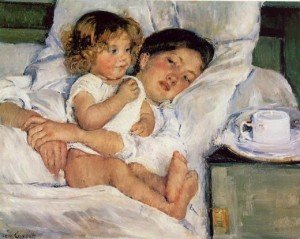
Cassatt began to turn more of her effort in the direction of printmaking: the process of reproducing an artist’s work by printing, normally on paper. Her first solo print exhibition occurred in 1891, with a series of highly original colored prints, including Woman Bathing and The Coiffure, inspired by the Japanese masters shown in Paris the year before. Cassatt was attracted to the simplicity and clarity of Japanese design, and the skillful use of blocks of color. In her intrepretation, she used primarily light, delicate pastel colors and avoided black.
A. Breeskin of the Smithsonian Institution notes that these colored prints, “now stand as her most original contribution adding a new chapter to the history of graphic arts technically, as color prints, they have never been surpassed.” Degas, upon seeings some of Mary Cassatt’s later work, was said to have stated, “I am not willing to admit that a woman can draw that well.”
Late Years
The 1890s were Cassatt’s busiest and most creative time. She had matured considerably and became more diplomatic and less blunt in her opinions. She also became a role model for young American artists who sought her advice. Though the Impressionist group disbanded, Cassatt still had contact with some of the members, including Renoir, Monet and Pissarro. During this time Cassatt also cared for her ill mother until her death in 1895.
As the new century arrived, she served as an advisor to several major art collectors and stipulated that they eventually donate their purchases to American art museums. However, recognition of her art came more slowly in the United States. Even among her family members back in America, she received little praise and was totally overshadowed by her famous brother Alexander Cassatt, (president of the Pennsylvania Railroad).
She continued to be very productive in the 1900s, but an increasing sentimentality is apparent in her work. Her paintings were popular with the public and the critics, but she was no longer breaking new ground, and her Impressionist colleagues who once provided stimulation and criticism were dying off. She was hostile to such new developments in art as post-Impressionism, Fauvism and Cubism.
A trip to Egypt in 1910 impressed Cassatt with the beauty of its ancient art, but not only had the trip exhausted her, but she declared herself “crushed by the strength of this Art. I fought against it but it conquered, it is surely the greatest Art the past has left us… how are my feeble hands to ever paint the effect on me.”
Diagnosed with diabetes, rheumatism, neuralgia and cataracts in 1911, Cassatt did not slow down, but after 1914 she was forced to stop painting as she became almost blind. Her diabetes began to create more serious health problems.
Nonetheless, she took up the cause of women’s suffrage, a feminist icon before the concept and the term had been invented. In 1915, she helped to organize a New York exhibition consisting of works by old masters, her friend Degas and eighteen of her own works, in order to raise funds to support the cause. Five years later, she witnessed the passage of the Nineteenth Amendment, which gave American women the right to vote.
In recognition of her contributions to the arts, France awarded her the Legion of Honor in 1904.
Mary Cassatt died on June 14, 1926 her home, Chateau de Beaufresne, near Paris, and was buried in the family vault at Mesnil-Theribus, France. She had become totally blind by her death.
Her work now hangs in the National Gallery, the Metropolitan Museum of Art, the Philadelphia Museum of Art, the Baltimore Museum of Art, the Pennsylvania Academy of the Fine Arts, and nearly a hundred other museums and public galleries throughout the world. Her paintings have sold for as much as $2.87 million.
Mary Cassatt Quote:
There’s only one thing in life for a woman; it’s to be a mother… A woman artist must be… capable of making primary sacrifices.
SOURCES
Wikipedia: Mary Cassatt
Mary Cassatt: Woman Painter
Mary Cassatt: A Woman of Independent Mind

